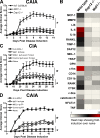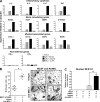Myeloid DAP12-associating lectin (MDL)-1 regulates synovial inflammation and bone erosion associated with autoimmune arthritis
- PMID: 20212065
- PMCID: PMC2839155
- DOI: 10.1084/jem.20090516
Myeloid DAP12-associating lectin (MDL)-1 regulates synovial inflammation and bone erosion associated with autoimmune arthritis
Abstract
DNAX adaptor protein 12 (DAP12) is a trans-membrane adaptor molecule that transduces activating signals in NK and myeloid cells. Absence of functional Dap12 results in osteoclast defects and bone abnormalities. Because DAP12 has no extracelluar binding domains, it must pair with cell surface receptors for signal transduction. There are at least 15 known DAP12-associating cell surface receptors with distinct temporal and cell type-specific expression patterns. Our aim was to determine which receptors may be important in DAP12-associated bone pathologies. Here, we identify myeloid DAP12-associating lectin (MDL)-1 receptor (also known as CLEC5A) as a key regulator of synovial injury and bone erosion during autoimmune joint inflammation. Activation of MDL-1 leads to enhanced recruitment of inflammatory macrophages and neutrophils to the joint and promotes bone erosion. Functional blockade of MDL-1 receptor via Mdl1 deletion or treatment with MDL-1-Ig fusion protein reduces the clinical signs of autoimmune joint inflammation. These findings suggest that MDL-1 receptor may be a therapeutic target for treatment of immune-mediated skeletal disorders.
Figures





References
-
- Barck K.H., Lee W.P., Diehl L.J., Ross J., Gribling P., Zhang Y., Nguyen K., van Bruggen N., Hurst S., Carano R.A. 2004. Quantification of cortical bone loss and repair for therapeutic evaluation in collagen-induced arthritis, by micro-computed tomography and automated image analysis. Arthritis Rheum. 50:3377–3386 10.1002/art.20557 - DOI - PubMed
Publication types
MeSH terms
Substances
LinkOut - more resources
Full Text Sources
Other Literature Sources
Molecular Biology Databases

